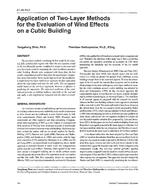Description
The two-layer methods combining the k-epsilon model in the external fully turbulent flow region with either the one-equation model or the low-Reynolds-number modified k-epsilon model in the near-wall area have been tested in computing the wind conditions around a cubic building. Results were compared with those from the k-epsilon model computation as well as those from the experiments. Comparison shows that neither the k-epsilon model approach nor the modified k-epsilon model-based two-layer method can represent the flow separation above the roof surface and near the side walls. The one-equation model based on the two-layer approach, however, is effective in predicting the separation. The numerical prediction of the wind-induced pressure on building surfaces, especially on the roof and side walls, is also improved as compared with the other two methods.
KEYWORDS: year 1996, calculating, wind pressure, buildings, turbulent flow, air flow, testing, comparing, experiment, models
Citation: Symposium Papers, Atlanta, GA, 1996
Product Details
- Published:
- 1996
- File Size:
- 1 file , 1.2 MB
- Product Code(s):
- D-16619




